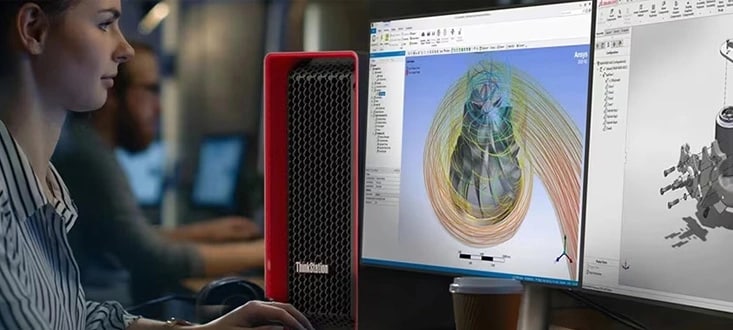-
Shop Lenovo Store
|
-

 Join a Community
Join a Community -

 Contact Us
Contact Us -

 Account
Account -

 Cart
Cart
What is the Intel® Evo platform?
If you've shopped for laptops lately, you've surely seen the Intel® Evo™ badge. It marks systems built on the new Intel® Evo platform – a promise of exceptional experience, anywhere you use your laptop.
Intel® and Lenovo have partnered to co-engineer an exciting lineup of premium, Evo-based laptops designed to keep up with today’s fast-paced lifestyle. The new models include some of Lenovo's thinnest, lightest, and fastest laptops, delivering verified, real-world performance with extreme processor speed, graphics performance, battery life, and more.
But what, exactly, is the Intel® Evo platform? At its simplest, the Evo platform is a defined hardware environment designed to achieve impressive performance benchmarks in new, highly portable laptops. At minimum, Evo-verified systems are powered by an 11th generation Intel® Core™ processor, powerful Intel® Iris® Xe or Intel® Iris® Xe MAX graphics, and a long list of high-end storge, networking and other components. Plus, to be Evo-verified, manufacturers must prove not only that a laptop has these parts but that it meets or exceeds strict Evo standards for responsiveness, unplugged times, and so on.
This means a laptop built on the Evo platform is more than a collection of popular features. Wherever you see the Intel® Evo badge, you can count on laptop designs with purposeful technologies optimised for the experience you crave.
You see, it's how all the pieces fit together that makes Intel® Evo laptops so impressive. A thin-and-light laptop is one thing. A thin, light, and powerful laptop that's built to Intel® Evo standards? It's what demanding laptop shoppers have been waiting for.
Lenovo laptops with Intel® Evo verification
Several Lenovo laptops have already earned the Intel®Evo™ badge, with more on the way. Look for impressive, Evo-verified, real-world-performance laptops in each of these popular Lenovo brands:
- Business-ready ThinkPad models: The most famous name in laptop technology
- Stylish IdeaPad ultraportables: Light and powerful – with good looks, too
- Flexible Yoga 2-in-1s: The laptop that flips into tablet mode and back again
- Lightweight ThinkBooks: Highly portable laptops for business, home, and school
Evo-verified laptops will soon be everywhere. But why wait? With Lenovo, you can get yours today.
What is the Intel® Evo vPro platform?
Best of all, you can get Evo-verification alongside other popular Intel® solutions that IT departments have used for years. One example is the Intel® vPro® platform, famous for delivering business-class performance, hardware-enhanced security features, superior remote manageability, and PC fleet stability.
Now there's the Intel® Evo™ vPro® platform (here's Intel® 's description) – perfect for highly mobile business users looking for a premium, secure laptop experience. On top of all the vPro capabilities, you get stylish, thin-and-light laptops with Evo-verified features including immersive displays, amazing visuals, remarkable responsiveness, instant wake-from-sleep, and long, real-world battery life.
Are you ready for the Intel® Evo and Intel® Evo vPro platforms? Keep reading to learn more.
Intel® Evo platform: Verified, real-world laptop performance
Some users determine the quality of a laptop based only on the specifications of the included processor, graphics, and other features. Does it have a highly rated Intel® Core CPU? Are the graphics integrated or discrete? How fast is the Wi-Fi? But those who don't follow the latest trends in laptop components typically ask a different question: How will the laptop work for me?
For this latter group, Intel® uses a set of real-world performance benchmarks to both verify new Intel® Evo™ platform laptops and describe their most important user benefits. These Key Experience Indicators (KEIs), Intel® says, help consumers identify the "best laptops for getting things done."1
An Intel® Evo platform laptop must deliver verified, real-world performance in each of the following KEI categories—all aimed at ensuring consistent, high-level operation in the areas Intel® believes laptop users value most:
- Consistent responsiveness while on battery power2
- Fast wake-from-sleep: Under 1 second
- "Real world" battery life: 9+ hours3
- Fast charging: 4-hour charge in under 30 minutes4
It's easy to see why Intel® Evo-verified laptops have won wide acclaim. The Evo platform KEIs aim to measure system performance in "real-world" conditions, not the perfect laboratory environments that are often used – and which actual laptop users can never hope to achieve.
Intel® Evo platform components
To achieve the real-world performance it promises, the Intel® Evo™ platform relies on a detailed set of required hardware and related components. A laptop can't earn the Evo badge unless it has at least these critical pieces:
- Processor and graphics
- 11th generation Intel® Core™ processor
- Intel® Iris® Xe or Intel® Iris® Xe MAX graphics
- Additional components
- 12" to 15" FHD touch display
- 256 GB PCIe NVMe SSD
- 8 GB dual-channel RAM
- Intel® Wi-Fi 6
- Thunderbolt™ 4
- Related capabilities
- Biometric login
- USB-C charging
- Optional Gigabit LTE connectivity
So, Intel® Evo verification involves more than just top-notch processing and graphics that keep performing for long hours on battery power. Laptops with the Evo badge also sport high-resolution displays, fast solid-state storge, screaming fast connectivity and ports, and secure fingerprint- or face-recognition login capabilities. They're truly impressive systems.
More about 11th generation Intel® Core mobile processors
Intel® unveiled its 11th generation Intel® Core™ laptop processors in late 2020, promising higher levels of performance and – in a major move – linking the new CPUs with the company's innovative Intel® Iris® Xe graphics to create the Intel® Evo™ platform. Within weeks, laptop manufacturers, including Lenovo, released their first Intel® Evo laptops to wide acclaim.
Using new SuperFin transistors, the first 11th gen Intel® mobile processors delivered turbo clock speeds up to 4.80 GHz. They also included Intel® Wi-Fi 6 (Gig +), Thunderbolt™ 4, a CPU-attached PCIe Gen4 interface, and more – all "industry-first" and/or "best-in-class" features, according to Intel® .
What do you get with an 11th gen Intel® Core U Series mobile processor? Performance. And speed. Just look at these Intel® -provided benchmarks:
- Up to 2.7x faster content creation5
- More than 20% faster office productivity6
- More than 2x faster gaming plus streaming7
In addition to an 11th gen Core processor, Evo-verified laptops also need to have Intel® Iris Xe graphics, which we explain in the next section.
More about Intel Iris Xe graphics
Intel® Iris® Xe graphics work within the company's longstanding integrated processor-graphics architecture. * But they're designed to deliver the performance of discrete or dedicated graphics chips. This makes Iris Xe graphics perfect for the thin-and-light laptops that are so popular today.
Traditionally, heavy graphics users such as video gamers and content creators have avoided the industry's most portable laptops. It's hard for manufacturers to fit all the needed features – top-flight processing and graphics, long-lasting batteries, heat sinks and cooling fans – into their smallest laptop frames. However, with Iris Xe, Intel® believes it has changed this equation forever.
What makes Iris Xe graphics different? Compared to earlier Intel® solutions, they've got more and faster execution units (EUs) and a much bigger L3 caches. While some AAA game titles might still be out of reach, early reviews of multiple Iris Xe-equipped laptops found them to have plenty of power to support today's most popular games – even when the graphics settings aren't at maximum.
*Shortly after introducing integrated Iris Xe graphics, Intel® launched its first discrete graphics option in nearly 20 years, Intel® Iris® Xe MAX. The dedicated Iris Xe MAX chip works with its integrated counterpart (Intel® calls them "twins") to split up and share graphics chores using new technology called Intel® Deep Link. Depending on what the user is doing, more power is allocated either to the MAX chip (with its onboard VRAM) or to the CPU. And when graphical demands are highest, Deep Link shares those tasks between the Iris Xe MAX chip and the integrated Iris Xe graphics on the CPU.
There you have it. If you need a speedy, easily portable laptop – for work or gaming or something else – be sure to consider a Lenovo laptop with Intel® Evo verification. Their technical specifications are impressive, and Intel® promises they'll deliver real-world performance that's hard to beat.
1 Measured by Project Athena laptop innovation program Key Experience Indicators and 11th Gen Intel® Core™ processor Representative Usage Guides. For more complete information about performance and benchmark results, visit www.intel.com/Evo and www.intel.com/11thGen.
2 Measured speed of premium Windows OS-based design while performing 25 workflows predictive of performance under a typical-use environment comprising multiple cloud-based and local apps and web pages including Google Chrome, Google G-Suite, Microsoft Office 365, YouTube and Zoom. Testing as of August 2020 conducted on laptops on DC battery ≥30%, connected to 802.11 wireless, and with shipped hardware configurations including Windows 10 and 250-nit screen brightness.
3 Time taken to drain from 100% to critical battery level while performing workflows under a typical-use environment, comprising multiple cloud-based and local apps and web pages including Google Chrome, Google G-Suite, Microsoft Office 365, YouTube and Zoom. Testing as of August 2020 conducted on laptops connected to 802.11 wireless, and with shipped hardware configurations including Windows 10 and 250-nit screen brightness.
4 Minimum charge attained in 30-minute window while powered off from OEM-default shutdown level. Performance varies by use, configuration and other factors. Testing as of August 2020.
5 Based on integrated Intel® Wi-Fi 6 (Gig+) and Thunderbolt™ 4 technology. Intel® Wi-Fi 6 (Gig+) products enable the fastest possible maximum speed for typical laptop Wi-Fi products. Thunderbolt™ 4 is the fastest port available on a laptop, at 40 Gb/s, as compared to other laptop I/O connection technologies including eSATA, USB, and IEEE 1394 Firewire*. Performance varies by use, configuration and other factors.
6 As measured by MLPerf v0.5 Inference with Offline Scenario using OpenVINO 2020.2 framework Closed ResNet50-v1.5 offline int8 GPU (Batch=32) on 11th Gen Intel® Core™ i7-1185G7 Processor vs OpenVINO 2020.2 framework Closed ResNet50-v1.5 offline FP32 GPU (Batch=32).
7 Verified, measured and tested against a premium specification and Key Experience Indicators as part of Intel's laptop innovation program Project Athena. Testing results as of August 2020, and do not guarantee individual laptop performance. Power and performance vary by use, configuration and other factors. For more complete information about performance and benchmark results, visit Intel.com/Evo.




